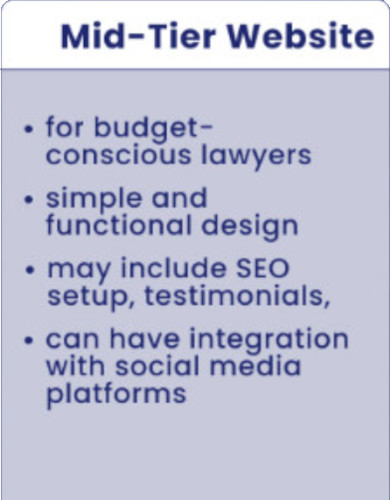Lawyer Most Popular Website Package
A popular lawyer website for solo and small law practices. It should be comprehensive, professional, and user-friendly. Here are some key elements it should contain:
1. Home Page
– Clear Branding: Logo, tagline, and a brief introduction of the firm.
– Navigation Menu: Easy-to-find links to other sections of the website.
– Call to Action (CTA): Prominent buttons for contacting the firm, booking consultations, or accessing key information.
2. About Us
– Firm History: Brief history and mission statement.
– Attorney Profiles: Photos, bios, and credentials of all attorneys.
– Awards and Recognitions: Any accolades or recognitions the firm or its lawyers have received.

3. Practice Areas
– Descriptions: Information about each area of law the firm practices.
– Case Studies/Success Stories: Examples of past cases and their outcomes, if confidentiality allows.
4. Client Resources
– Blog/Articles: Legal advice, news, and insights written by the attorneys.
– FAQs: Common questions and answers about legal services and processes.
– Downloadable Resources: Forms, guides, and other helpful documents.
5. Testimonials
– Client Reviews: Positive feedback and testimonials from past clients.
– Case Studies: In-depth looks at particularly successful cases.
6. Contact Information
– Contact Form: Easy-to-fill form for inquiries.
– Phone Number, Email, and Address, Business Hours
7. Appointment Scheduling
– Online Booking and Calendar
9. Client Portal
– Secure Login: Access to case documents and communication for existing clients.
– Payment Options: Online payment functionality for services.
10. Accessibility and Usability
– Mobile-Friendly Design: Ensure the website is responsive and looks good on all devices.
– Fast Load Times: Optimized for quick loading.
– Accessibility Features: Compliance with accessibility standards for users with disabilities.
11. Privacy Policy and Terms of Service
– Legal Notices: Clear policies regarding privacy, terms of use, and disclaimers.
12. Social Media Integration
– Social Media Links: Buttons linking to the firm’s social media profiles.
– Share Buttons: Allow users to share content on their social networks.
13. SEO and Analytics
– Search Engine Optimization (SEO): Well-optimized content for search engines
– Analytics Tools: Integration with tools like Google Analytics to track website performance.
These elements help ensure that a lawyer’s website is informative, professional, and provides a good user experience, which can help attract and retain clients.
